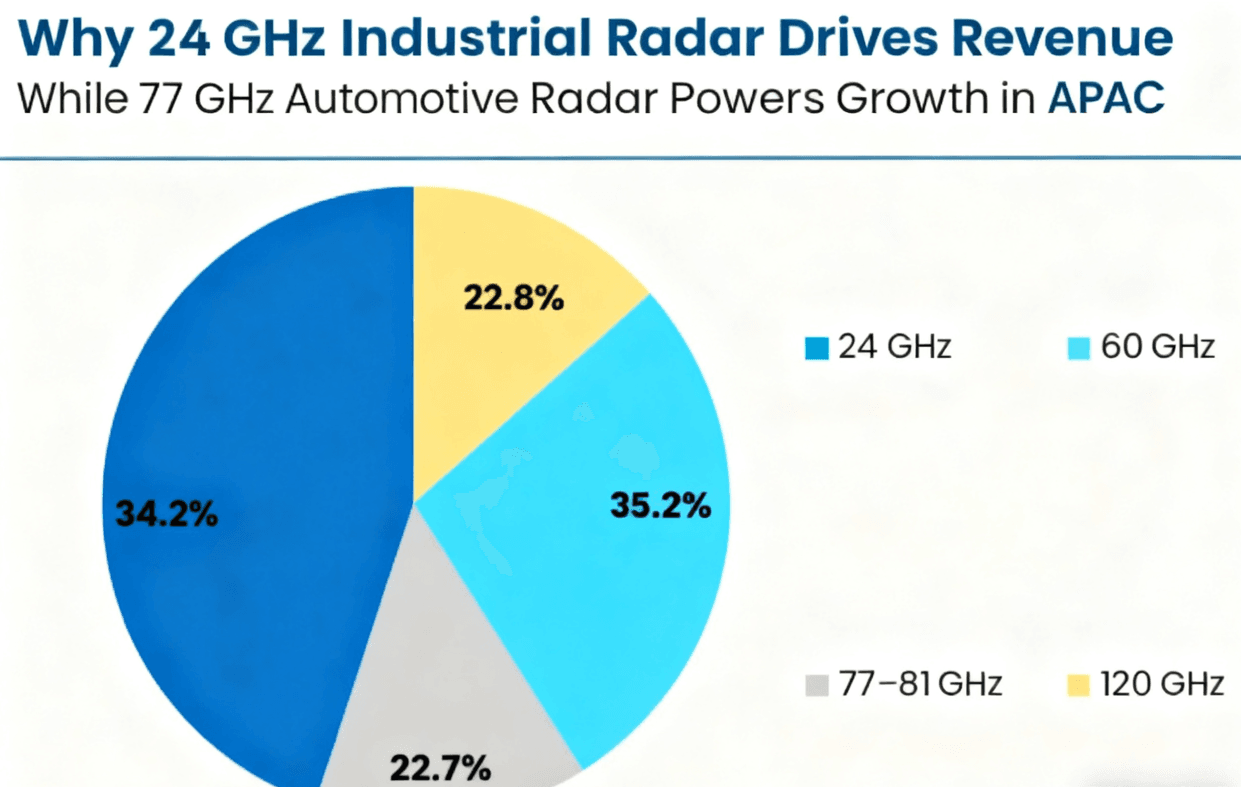The market for millimeter-wave (mmWave) radars shows a distinct dual-track development, with 77 GHz automotive radars emerging as the primary growth engine and 24 GHz industrial radars supporting current revenues. For investors, automotive electronics decision-makers, and smart manufacturing solution providers, understanding this divergence is critical for strategic planning and technology investment.
1. 24 GHz Industrial Radar: A Stable Revenue Base
Proven Technology and Reliability
After years of use in industrial IoT, smart parking, liquid-level monitoring, and obstacle avoidance in home appliances, 24 GHz radars have advanced. These radars provide consistent, long-term performance even in complex industrial environments, establishing a dependable revenue stream.
In water infrastructure projects, 24 GHz radars continuously monitor water levels in environments with dust, steam, and changing lighting. The Water Engineering Monitoring Case Study has more details.
Industrial applications are versatile.
From smart water management to agricultural monitoring, warehouse safety, and autonomous material handling, 24 GHz radars strike the right balance between detection range, resolution, and cost efficiency. For example, in automated warehouse logistics, 24 GHz radar improves AGV (Automated Guided Vehicle) navigation safety, lowering collision risk and increasing operational efficiency.
Linpowave Industrial Radar Solutions provides comprehensive industrial radar solutions.
Domestic substitution and supply chain advantages
In the context of China's "domestic control" policy, 24 GHz radar provides a moderate technological barrier, allowing for scalable domestic production and import substitution. This reduces procurement risk while also promoting R&D and capital accumulation for higher-frequency radar development.
In summary, 24 GHz industrial radar, which is distinguished by advanced technology, dependability, and scalable production, is a cash flow anchor.
2. 77 GHz Automotive Radar: The Growth Engine
Rigid Demand from ADAS and Autonomous Driving
77 GHz radars offer better detection accuracy and resolution due to their larger bandwidth and shorter wavelengths. 77 GHz radars are becoming necessary for forward collision warning, blind spot monitoring, and lane-keeping assistance as the use of L3+ autonomous driving picks up speed.
Detailed insights: Yole Intelligence Imaging Radar Report 2024
APAC Market: Policy and Technology Driven
The Asia-Pacific region is the most rapidly expanding market for 77 GHz radars. Regulations, subsidies, and market policies in countries such as China, India, and Japan encourage the use of electric vehicles and advanced driver-assistance systems (ADAS). For example, China's Intelligent and Connected Vehicle Roadmap 2.0 aims to achieve 50% L2/L3 vehicle penetration by 2025.
Domestic companies have successfully designed and produced automotive-grade 77 GHz radar chips.They can respond quickly to market demand by leveraging cost advantages and localized supply chains.
| Region | CAGR (2025–2035) | Above Global Average |
|---|---|---|
| China | 8.1% | +2.1% |
| India | 7.5% | +1.5% |
| Global Avg | 6.0% | — |
High-Value Chain and Technical Added Value
The value of 77 GHz radars is found not only in the hardware but also in signal processing and algorithm optimization. The RF front-end contributes approximately 40% of the overall value, while backend algorithms and data processing contribute more than 50%. Companies that have strong algorithmic capabilities will maintain technical leadership and premium market positioning.
Linpowave Automotive Radar Solutions contains information on automotive radar solutions.
3. Core Drivers of the Growth Shift
-
Technological Advancements and Cost Reduction
Advanced processes, such as SiGe BiCMOS, reduce the cost of 77 GHz radar, allowing it to be used in vehicles ranging from high-end to mid-range models. After 2025, market adoption is expected to accelerate. -
Expanding Application Scenarios
Aside from automotive applications, 77 GHz radars have growth potential in UAV obstacle avoidance, smart transportation, and security monitoring, providing a variety of revenue streams. -
Policy and Capital Synergy
Government policies continue to encourage intelligent connected vehicles, while capital investment in semiconductors and automotive electronics speeds up technology deployment and mass production of 77 GHz radars.
4. Perspectives for Investors and Industry Decision -Makers
-
Revenue vs. Growth: 24 GHz industrial radar generates consistent cash flow, which supports current revenue. The main growth drivers for the industry over the next decade will be 77 GHz automotive radar and its derivative applications.
-
Technology and Supply Chain Strategy: Market leadership will be determined by expertise in automotive-grade radar manufacturing, algorithm optimization, and regional supply chain resilience.
-
APAC Market Advantage: With policy support, technological maturity, and capital investment, Asia-Pacific is poised to become the primary growth engine and innovation hub for mmWave radar.
In conclusion, the market for millimeter-wave radar uses a dual-track model. While 77 GHz automotive radar offers high-value growth potential, 24 GHz industrial radar is dependable and revenue-stable. Those who successfully implement high-frequency radar technology in APAC and command core algorithm capabilities will benefit from market leadership.
FAQ
Q1: What are the primary ways that 24 GHz and 77 GHz radars differ in their applications?
A: 24 GHz radars are used in warehouse logistics, industrial IoT, and liquid-level monitoring with an emphasis on cost-effectiveness and stability. With an emphasis on high resolution, long-range detection, and algorithm capabilities, 77 GHz radars are designed for automotive ADAS and autonomous driving.
Q2: Why is there more interest in 77 GHz radar among investors?
A: 77 GHz radars are the primary growth segment due to their quicker market expansion, greater technical value, and robust demand in the APAC automotive and electric vehicle markets.
Q3: How should businesses approach the market for 77 GHz radar?
A: Building robust APAC supply chains, optimizing algorithms, and producing automotive-grade chips are important tactics for securing long-term competitive advantages.
Q4: Is there still room for growth in 24 GHz industrial radar?
A: Definitely, especially when it comes to industrial automation, smart manufacturing, and domestic substitution policies. Nevertheless, compared to high-frequency automotive radars, its growth rate is slower.
Q5: Where can readers find comprehensive product solutions?
A: Linpowave Industrial Radar is an industrial radar solution.
Linpowave Automotive Radar solutions for automobiles



